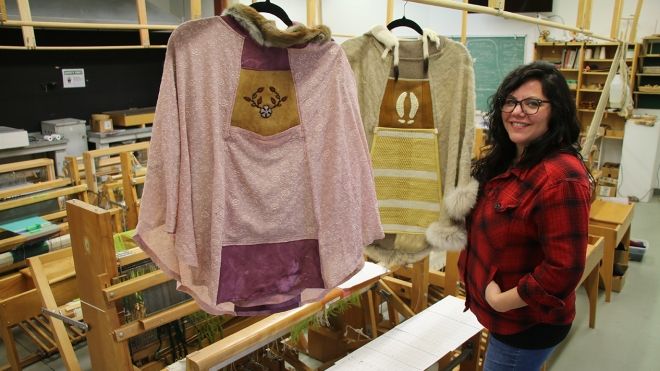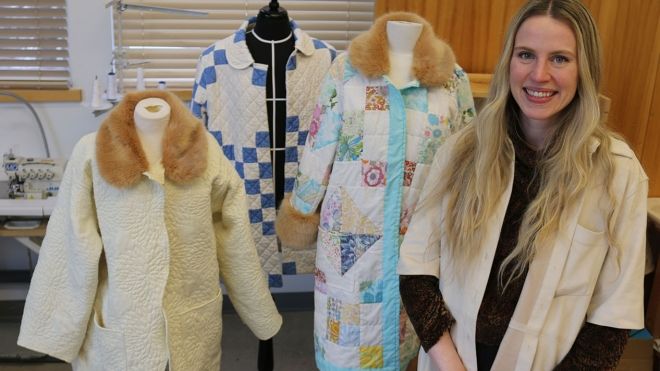Textile Arts - Certificate
Overview
Please note, this program is no longer accepting applications.
If you are interested in potential future craft arts programming, please fill out an interest form. Please note that any future Kootenay School of the Arts programming will be delivered by a third party, not Selkirk College.
This program emphasizes developing skills and a high level of proficiency within a diverse range of techniques. You will have the opportunity to engage in many areas of study, including weaving, felting, dyeing, screen printing and pattern drafting.
Explore a Range of Techniques
- Dye technology
- Textile construction and pattern drafting
- Surface and structure
- Textile-specific design
- Surface and structure
- Printing on cloth
- Weaving
- Production and product development
This program is designed to cultivate an environment of creative problem-solving and thinking in conjunction with hands-on studio work, supporting students in becoming efficient creative makers in their chosen field of textiles.
Artist in Residence Naomi Bourque showcased her textiles show Medicine Harvest at the Indigenous Fashion Arts Festival in Toronto this past June. Check out the video about Naomi and her process below.
News
Program Outcomes
Upon successful completion of this program, students will be able to:
- Utilize a variety of traditional and contemporary applied textile techniques
- Demonstrate skill in and knowledge of a range of traditional and contemporary textile techniques
- Produce textile objects that reflect a critical understanding of contemporary art, craft and design
- Analyze the characteristic properties of textile materials, fibres and processes for use in the design and production of textile objects
- Follow a creative process of research, ideation, visualization, analysis, production and evaluation
- Critique projects individually and in group settings
- Incorporate feedback into a project
- Demonstrate knowledge of marketing, entrepreneurship, wholesale/retail pricing and contexts of production for textile development
- Follow industry health and safety guidelines for the use of equipment, materials and processes
Admission Requirements
In addition to meeting the general entrance requirements for admission to Selkirk College, an applicant must meet the following Textile Arts Program entrance requirements:
- English at a grade 12 level with a minimum of 60%.
- Students whose first language is not English must fulfill the college’s English language proficiency requirement. See Policy 8611: Admissions.
- Submit a completed admission application form and other required documents (i.e., secondary school and any post-secondary transcripts) to the Admissions Office.
- Questionnaire
All applicants must complete and submit a questionnaire at least one week prior to their scheduled interview date. The questionnaire helps us to understand the applicant’s interest and commitment to the studio program.
Submit a questionnaire using the Kootenay Studio Arts (KSA) online form.
- Interview
All applicants are required to participate in an interview with a program instructor from KSA. Telephone interviews will be arranged for those applicants who, because of distance, cannot attend in person.
The interview is an opportunity for applicants to introduce themselves, present their work and discuss their interests within the arts. The instructor will assess the applicant’s preparedness for entry into the program and will ask about commitment, goals and expectations, design knowledge, experience and communication skills. It is also an opportunity for applicants to ask any questions they might have about the program and for faculty to recommend upgrading if necessary.
- Portfolio
The portfolio is designed to assess your skill level to help instructors increase your chances of success in your studio program. KSA is looking for a demonstration of visual awareness, creativity and technical skill. The portfolio pieces may be of any medium and they need not be specific to studio preference.
For portfolio guidelines, see our website.
APPLICATION PROCESS
1. Before an applicant's file is considered to be complete the following must have been received or marked complete by the admissions office:
a) Completed application form.
b) Official transcripts of high school grades and interim statement of grades is acceptable if applicant is currently a high school student.
c) Official transcripts of all post-secondary education grades.
d) Applicant information questionnaire.
e) Portfolio submission.
f) Interview.
2. Students wishing to enroll in the Textile Arts Program on a part-time basis may do so providing the same entry requirements as full-time students, as stated in Part A, have been met. Part-time students are accepted only if space is available after all full-time students are scheduled, and only with permission of the school chair.
A. PROMOTION
1. Admission to a given semester requires completion of all required courses with a minimum cumulative GPA of 2.00 and no more than one (1) failure grade in the previous semester courses. Any student with more than one (1) failure must have the school chair's approval to progress to the next semester. Students receiving a final grade of "F" in a prerequisite course will not be allowed to register in a subsequent course requiring that prerequisite.
2. To be qualified for admission into a course which stipulates a prerequisite, a minimum grade of "C" must be achieved in the prerequisite course, unless otherwise specified.
B. GRADUATION
In order to qualify for a Selkirk College Textile Arts Certificate, a student must complete all of the following courses with a minimum final grade of “P” in each course and an overall GPA of 2.00 or better. See Policy 8617: Graduation
Courses
TEXT131 - Dye Technology I - Plant Dye and Modifiers
TEXT 131 Dye Technology I - Plant Dye and Modifiers is an introductory study of the application of color on fibre through direct application and immersion dye processes. Utilizing a variety of natural fibres, yarns and fabric, plant dyes will be explored within a contemporary context. Indigo, as the ancient, natural blue, will be more fully worked with through the practice of shibori resist techniques.
TEXT133 - Textile Construction and Pattern Drafting I
TEXT 133 Textile Construction and Pattern Drafting I is an introduction to sewing techniques, machine and hand finishing and embellishments. Students also learn stitching and textile manipulation for fashion, costume, wearable art, and 2 and 3D objects. Students will design and plan projects, along with constructing and drafting patterns, prototypes and wearables. The focus will be on lower body garments such as skirts and pants.
TEXT137 - Surface and Structure
TEXT137 Surface and Structure introduces students to silkscreening and wet felting. The silkscreening section focuses on creating repeat patterns utilizing a variety of dyes, chemicals, and natural material. The felting section introduces students to traditional felting techniques within a contemporary context, with an emphasis on creating felted yardages that combine a variety of techniques to create pattern and texture on felted cloth.
TEXT138 - Textile Design
TEXT 138 Textile Design will introduce students to the elements and principles of design that inform the diverse field of contemporary textile arts. Critical analysis and discussion will play a role in developing a language of visual design that brings together drawing, materials, and context. Through two- and three-dimensional projects and research, students will investigate the process of textile design as a means of making images, textures, surfaces, and constructed objects.
TEXT134 - Textile Construction and Pattern Drafting II
TEXT 134 Pattern Construction and Drafting II introduces students to pattern drafting, styling and draping on the dress form for ready-to-wear and wearable art clothing and accessories. Students will learn to create patterns, transfer patterns to paper, make adjustments and alterations, transfer patterns to fabrics and construct garments. Special attention will be paid to design, creativity, problem solving, and craftsmanship.
TEXT136 - Weaving
TEXT 136 Weaving is an introduction to the language of colour, pattern and design in the construction of cloth through the study of weave structures utilizing multiple shaft looms. Students will learn how to produce cloth on the loom from concept to finished textile, including various finishing techniques. Students will also be able to create drawdowns and to develop drafted patterns for woven cloth.
Tuition & Fees
All amounts are estimates and are subject to change. Tuition amounts are based on a full-time course load. Please note that many programs have additional costs beyond those listed here. For more information, please visit Tuition & Fees.
Find Out More
We look forward to connecting with you! Fill out this form and we'll reach out to you.


